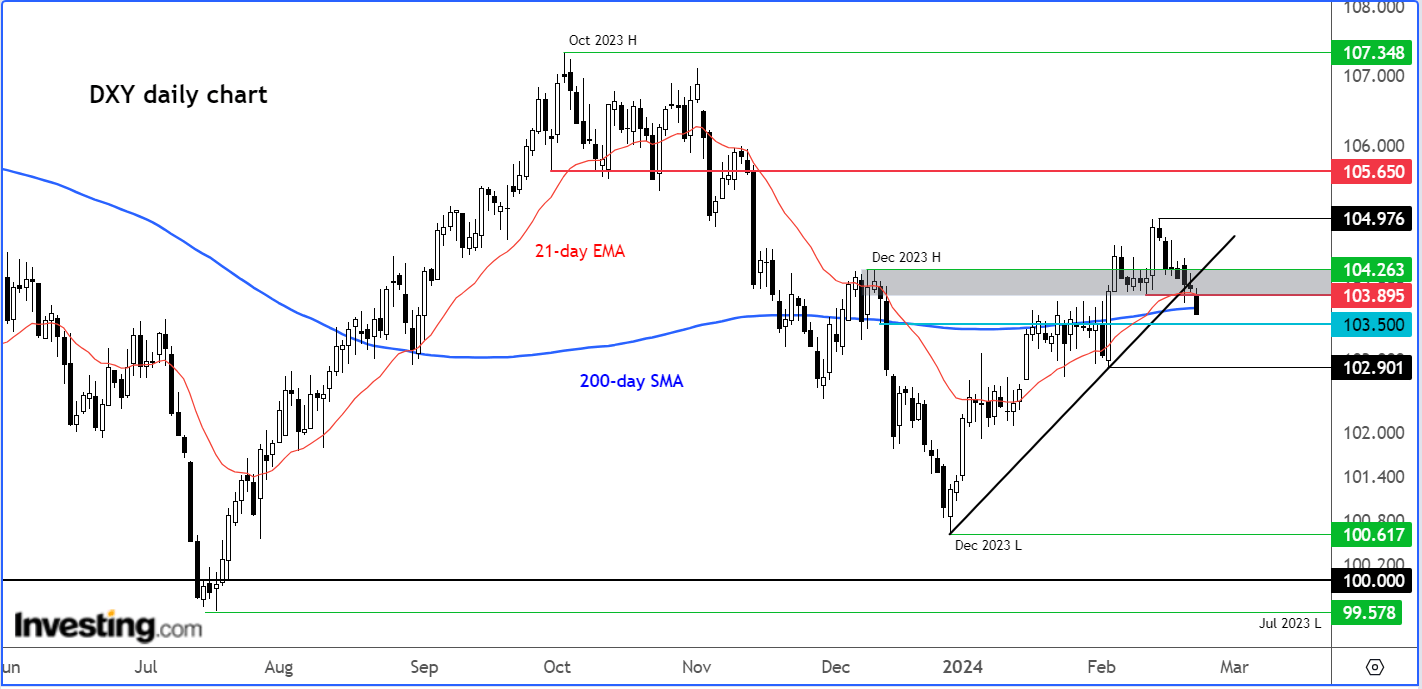DXY
-0.06%
Add to/Remove from Watchlist
Add to Watchlist
Add Position
Position added successfully to:
Please name your holdings portfolio
Type:
BUY
SELL
Date:
Amount:
Price
Point Value:
Leverage:
1:1
1:10
1:25
1:50
1:100
1:200
1:400
1:500
1:1000
Commission:
Create New Watchlist
Create
Create a new holdings portfolio
Add
Create
+ Add another position
Close
EUR/USD
+0.02%
Add to/Remove from Watchlist
Add to Watchlist
Add Position
Position added successfully to:
Please name your holdings portfolio
Type:
BUY
SELL
Date:
Amount:
Price
Point Value:
Leverage:
1:1
1:10
1:25
1:50
1:100
1:200
1:400
1:500
1:1000
Commission:
Create New Watchlist
Create
Create a new holdings portfolio
Add
Create
+ Add another position
Close
GBP/USD
+0.19%
Add to/Remove from Watchlist
Add to Watchlist
Add Position
Position added successfully to:
Please name your holdings portfolio
Type:
BUY
SELL
Date:
Amount:
Price
Point Value:
Leverage:
1:1
1:10
1:25
1:50
1:100
1:200
1:400
1:500
1:1000
Commission:
Create New Watchlist
Create
Create a new holdings portfolio
Add
Create
+ Add another position
Close
USD/JPY
+0.20%
Add to/Remove from Watchlist
Add to Watchlist
Add Position
Position added successfully to:
Please name your holdings portfolio
Type:
BUY
SELL
Date:
Amount:
Price
Point Value:
Leverage:
1:1
1:10
1:25
1:50
1:100
1:200
1:400
1:500
1:1000
Commission:
Create New Watchlist
Create
Create a new holdings portfolio
Add
Create
+ Add another position
Close
USD/CHF
+0.22%
Add to/Remove from Watchlist
Add to Watchlist
Add Position
Position added successfully to:
Please name your holdings portfolio
Type:
BUY
SELL
Date:
Amount:
Price
Point Value:
Leverage:
1:1
1:10
1:25
1:50
1:100
1:200
1:400
1:500
1:1000
Commission:
Create New Watchlist
Create
Create a new holdings portfolio
Add
Create
+ Add another position
Close
USD/NZD
-0.27%
Add to/Remove from Watchlist
Add to Watchlist
Add Position
Position added successfully to:
Please name your holdings portfolio
Type:
BUY
SELL
Date:
Amount:
Price
Point Value:
Leverage:
1:1
1:10
1:25
1:50
1:100
1:200
1:400
1:500
1:1000
Commission:
Create New Watchlist
Create
Create a new holdings portfolio
Add
Create
+ Add another position
Close
US dollar weakens as commodity currencies gain on positive risk sentiment and strong Nvidia earnings.
European trading sees further dollar weakening despite initial gains, driven by disappointing German PMI figures.
Dollar’s decline may be limited, however, without significant deterioration in US data, with factors like interest rate differentials suggesting potential upside risks.
Invest like the big funds for under $9/month with our AI-powered ProPicks stock selection tool. Learn more here>>
The US dollar staged a bit of a sell-off overnight, with commodity-linked currencies showing strong performance.
This was driven by an already positive risk sentiment, which received an additional boost from Nvidia’s (NASDAQ:NVDA) earnings surpassing forecasts and its optimistic outlook, sending the Nasdaq 100 futures soaring towards new record levels and buoying Asian markets.
Subsequently, in early European trading, the greenback continued to weaken as the German DAX index reached fresh all-time highs. FX pairs like EUR/USD and GBP/USD gained momentum, fueled by better-than-anticipated PMI data from France.
However, later-released German PMI figures fell short of expectations, with manufacturing activity dropping from 45.5 to 42.3. This helped to keep the EUR/USD below the 1.09 mark.
The US dollar may be weak now, but the bears will find it increasingly difficult to justify a big move lower. If anything, the risks are now skewed to the upside for the greenback.
Dollar: fundamental trade ideas
In the absence of significant deterioration in incoming US data, it’s challenging to adopt a bearish stance on the dollar. Nonetheless, it remains crucial to select the appropriate currency pair when trading the dollar, regardless of whether one is bullish or bearish.
Those taking a bearish view on the greenback would be wise to consider currencies with relatively high interest rates, such as the NZD or GBP. Conversely, currencies like the CHF and especially the JPY, which remains the standout funding currency with negative interest rates in Japan, are more suited for shorting against the dollar.
At least, this has been the prevailing trend thus far in 2024 anyway, with the JPY down approximately 6% against the dollar year-to-date. I don’t anticipate a significant reversal for the yen until the Bank of Japan signals a departure from negative rates or the Federal Reserve hints at an impending rate cut.
Even stronger-performing currencies like the GBP and NZD are likely to struggle to sustain recent gains without clear evidence of an imminent downturn in the US economy necessitating looser monetary policy.
Dollar bears need to see weakness in US data
Despite last week’s higher-than-expected inflation figures, the dollar has struggled to find additional support. Both CPI and PPI surpassed expectations, yet the greenback has weakened anyway.
Profit-taking may be a contributing factor, particularly given the relatively quieter economic calendar this week. While those inflation indicators did lead to an increase in bond yields, the FX markets have largely brushed off the data. Nevertheless, without any substantial data or news to significantly impede the dollar’s rally this year, it’s challenging to envision this week’s weakness persisting for long.
With US 10-year bonds offering yields of approximately 4.30%, this should maintain support for the greenback compared to currencies with comparatively lower yields (such as the JPY) and those where economic data doesn’t show significant strength (like the EUR).
Therefore, for the dollar to experience a notable decline, we would need to observe a noticeable deterioration in incoming US data. The release of the FOMC meeting minutes on Wednesday served as a reminder that the Federal Reserve is not in a hurry to cut rates, which isn’t surprising given the hawkish tone we’ve heard from various officials at the central bank recently.
Dollar index technical analysis
 DXY Daily
DXY Daily
The dollar index has broken a few support levels since peaking at just under 105.00 last week.
Among the levels that were broken are 104.26, the December high, and 103.90, the low from last week. The area between these two levels i.e., the 103.90-104.26 range, must now be defended on any fresh dollar rebound, if the bears want to exert pressure.
However, given the above macro factors discussed, I am doubtful that the dollar weakness will persist and will therefore be looking for a move back above this area to provide a bullish signal on the dollar. Should that happen, then 105.00 (i.e., liquidity above last week’s high) could be the next stop.
In terms of support, 103.50 is a very important level to watch given that it had served as strong resistance in the past (the bodies of the daily candles from around mid-January were all formed below this level until the breakout in early February).
The line in the sand for me is at 102.90 now, the low from earlier this month. A potential move below here, would probably signal the end of the bullish trend.
Be sure to check out InvestingPro to stay in sync with the market trend and what it means for your trading. As with any investment, it’s crucial to research extensively before making any decisions.
InvestingPro empowers investors to make informed decisions by providing a comprehensive analysis of undervalued stocks with the potential for significant upside in the market.
Subscribe here for under $9/month and never miss a bull market again!
 Subscribe Now!
Subscribe Now!
Don’t forget your free gift! Use coupon codes OAPRO1 and OAPRO2 at checkout to claim an extra 10% off on the Pro yearly and bi-yearly plans.
Disclaimer: This article is written for informational purposes only; it does not constitute a solicitation, offer, advice, or recommendation to invest as such it is not intended to incentivize the purchase of assets in any way. I would like to remind you that any type of asset, is evaluated from multiple points of view and is highly risky and therefore, any investment decision and the associated risk remains with the investor.
Read my articles at City Index
Source: Investing.com



























